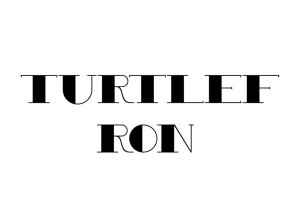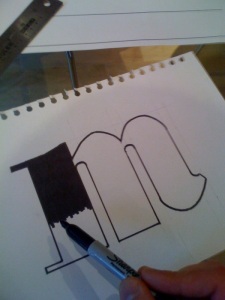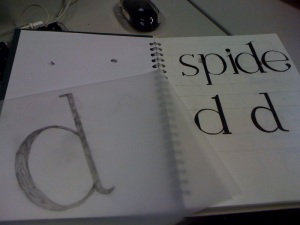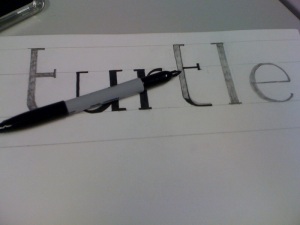My research up until now has led me to extablish that the most common usage for a conceptual typeface today tends to be in the application of branding, with companies today seeking bespoke typefaces that only they have the rights to, to generate an identity that can be applied over a broader spectrum.
Taking this into consideration I’ve decided that the most appropriate outcome for my project would be to create a bespoke typeface to a particular brand.
The brand in this case being the Louis Rocca Trophy.
Initially I had set out to create a typeface with both Italian and English styles playing an intergral part in dictating the style of my design, however I didn’t really have a particular application in which to apply this new typeface. So I went back to my research to see if there was anything I could use to write a branding brief for myself. I didn’t want to stray too far from the point I was already at, so I decided to start with Louis Rocca and found what I believe to be a suitable application for my design.
In 2005 Salford based artist Hatrold Riley had the idea of creating a memorial match in honor of Louis Rocca, The match was called The Louis Rocca Trophy and was played out between Salford Boys and Glasgow Boys football clubs and even caught the attention of Sir Alex Ferguson who talked sports brand Nike into making commemorative one of football shirts for the occasion.
http://www.manchestereveningnews.co.uk/sport/football/manchester_united/s/150/150852_rileys_plan_to_honour_rocca.html
Unfortunately as far as I can make out the match was only ever played once and there is limited information and no photgraphs of the occasion; however, I felt that this was a significant enough event for me to base a branding brief on and a legitiment reason to create a bespoke typeface with both Italian and English styles incorporated within it.
Today there are many leagues, trophies and cups that football teams compete in at both club and international level, I have already ellaborated on the Champions League identity which Font Smith created the typeface for, and resulted in the typeface having a range of applications, including the clock and score update in the corner of live TV broadcasts of the matches themselves. The FIFA World Cup in particular is almost as famous for it’s identities as the olympics.






Just these few images demonstrate how important football organisations deem the identity of their competitions to be, of course many of them now are dictated by the existing identity of the cups sponsor, but there is still a problem that requires a design solution, how do you create an identity for a football trophy that incorporates the sponsors identity as well? The FA Cup is a good example of this as it takes a very simple principle in that most people associate the colour combination of red and blue with sport, for example in boxing traditionally there has always been the red corner and the blue corner, and even just by searching “football comic strip” in google image search this image was one of the first results;

http://blogs.coventrytelegraph.net/thegeekfiles/Roy%20of%20the%20Rovers.jpg
The layout of the FA Cup logo itself is a design we see time and time again in the sports world, the designers have obviously considered this and gone with a formula that has proven to be popular (the following formula).


This is somewhat distracting me from what I am trying to do however, as I am more conserned about using a typeface as an identity rather than colours and graphics, obviously these will play an integral role in to the considertaion of how my typeface should look as there is going to be some sort of relationship between text and images somewhere down the line, but for now I want to remain more forcused on what kind of application my final typeface is going to have.
As I want to brand The Louis Rocca Trophy I need to understand what application the typeface is going to have, initial thoughts bring the obvious to mind such as ticket stubs, posters and matchday programmes, all very different mediums with different purposes which could mean very different typefaces, for example; a matchday programme is a small hand held booklet or magazine that has information about both squads occasionally interviews with players or staff prior to the game and other articles, dictating that the programme is going to be very heavly text based with thousands of words to relay. Ultimately for a matchday programme to be succesful and fulfill it’s task text needs to be legible at a small scale and traditionally it’s widely believed that serifed faces communicate better at small point sizes, (a debate that’s ongoing and ultimately in-conclusive). So based on this my typeface should be a serifed face that works well at small scales and incorporates English and Italian styles, but that’s probably not going to be the best solution for posters, generally typefaces that are designed to work well at small scales simply don’t work at large scales, little tricks and design tweaks that are designed to create optical illusions at smaller scale to make letters seem uniform become much more obvious at large scale and can be deemed as accidental flaws or inconsistenies by the target audience. Therefore a secondary typeface is going to be required which works at point sizes regarded as headline size meaning that I now have two typefaces to design, this is not a problem however, to be deemed as part of the same font each typeface must have similar characteristics to other, and it will be the smaller details within the constrauction of the letter forms that will vary.
My initial research into English and Italian typefaces does throw up for me an obvious solution, many of the English typefaces I have looked at such as Times, Garamond and Sally work well as text faces for the reasons previously stated. Itaian faces such as Bodoni with contrasting thick and thin strokes lose a great deal of detail at smaller point sizes, rendering them primarily useful as headline faces, a good example of this tends to be womens luxury fashion magazines.

My solution therefore, is to generate two faces which belong to the same font family, the headline face will be mainly Italian in characteristics with subtle English undertones and vice versa for the text weight. This ensures I am covering my concept of an English / Italian hybrid (due to the fact that Rocca was an Englishman of Italian origin or an English based Italian) and further more I want the essence of Rocca to come through within the font, Rocca was a handy man and had many roles at MUFC; therfore by creating more than one weight for my font I am creating something that has multiple applications (as did Rocca).
This is one of my first digitally rendered ideas for the “Rocca” typeface;

Basically what I have tried to do here is create a typeface with a fairly clear contrast between thick and thin strokes (a mainly Italain feature) as well as light slab serifs on the base; however, letters with ascenders such as d and h have had a barbed serif incorportated into them, this is the English aspect of the typeface. I have made the typeface fairly geometric in style and relied a bit too heavily on fairly rigid measuremnt restrictions sanctioned by myself which has resulted in diagonal strokes appearing a lot narrower than upright ones.

To get an idea of how my text would look at larger scales I produced this mock up poster based on a style that I felt suited the typeface particulalry well. To me it is quite apparent that the typeface design I have come up with so far has an almost Art Deco feel to it, reminiscent of the 1930’s. This has resulted in the selection of the image and tone for the poster. One thing that is quite clear from this design however, is the way letters like the x in the top line appear taller than the rest of the letters, this is due to the fact that the other letters have a barbed serif that slopes upwards to a point, creating an unrhythmic look to the line of text.

This is one of the early styles that I looked at, I wanted to start with my bold / headline face because I felt it would be easier to create a raw version that I could refine a text version from. This particular version shows how much I could push the contrats between thick and thin, I feel I have somewhat over sized the stroke in areas and it has lost the Italian aspect and isn’t as elegant as I would perhaps have liked.

This was another early idea I was playiong around with, It was basically an experiment to see how much I could repeat from various letters to create new ones. One of the most Important things I have learnt so far about typeface design is to always ensure there is consitency in the style of every single letter and that one letter looking out of place is enough to throw the entire design off balance.

This image is an example of how much consideration has gone into each letter and how many versions I have been generating for each letterform. Admittidely some letters have recieved a bit more experimentation than others but I have learnt to rely more on my eyes in terms how things visually appear, rather than to measure everything as this often produces irrelgular looking letters that optically appear unrefined and unbalanced. The above example depicts some letters which appear more refined than others and are the designs I’ve chosen to progress further, The problem I have had in some cases however has been that a ceratin style may work well for one letter but not for an other, this results in individual letters looking complete and fully refined, but once put together the lack of consistency is instantly apparent.

This is the uppercase version of my typeface and ultimately I feel it already looks more refined than the lowercase version. the most difficult element I found with designing this part of the typeface was ensuring that uppercase and lowercase where explicitly part of the same family. Although neither case is anywhere near being completed, the following image depicts that they are clearly related and work together.

Again in this version the lack of rhythm is instantly apparent where irregular serifs break up the order of the sentence.
Once I had a basic style that I was content with I set about designing the text weight of my font. Having seen the results of relying too much on specific measurements on my bold face which resulted in some clumsy looking letters, I decided to tackle this version by refering more to “what looks right” rather than what logically seems right, this was advice I was often recieving from other typeface designers and my tutor. The results of the lowercase designs follow:

Straight away it is clear to see that this typeface is already more refined than the headline version; however, the essence of the original design is still there and my advice from here was to “cross – pollinate” the two styles, as there where aspects my peers liked from both styles.
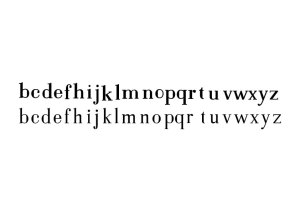
I haven’t completed the entire process yet as there are a few letters missing, but what I have done is make the bold face slightly less geometiric, with circular elements becoming more elipse shaped. I have also tried to work on the stroke in some places to create more regular looking letterforms. One thing that is clear to see is that the initial “cross polination” has been a success as it is apparent that these two designs are clearly related.
As I am fairly happy with the uppercase version of my bold face I decided to go ahead and design the uppercase set for my text weight, there are still a few letters that are incomplete and therefore have been omitted, but I thought it best to design the text uppercase first and then I could use the same “cross pollination” technique to refine the bold uppercase face.
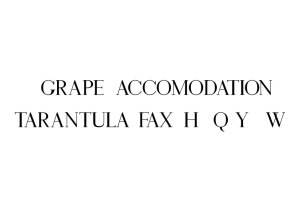
Initially I was very pleased with the early results of this design, I felt that I had captured the elegence of Itaian typeface design as well as increasing readibility, an aspect of English typefaces; however, when I began using upper and lower case together it was instantly clear that the capiutals where too lighweight and appeared to be of a completely different weight. The reason for this is because I slipped back into my habbit of measuring too much and went on the proportions of my lowercase design resulting on an almost ultra thin uppercase weight. I wasn’t too disheartened however, because I knew there was always the possibility of slimming down the lowercase text weight even more and creating a third typeface that was either a thin or ultra thin weight. This poses another issue however! If I do decide to create a thin version it is going to be useless at small scales as thin strokes will simply vanish upon printing, the result of this is that it will only be useful at large scales thus another headline weight which I have already designed. It’s not something I want to dismiss just yet as having two healine weights, one bold and one thin could still be practical as they each communicate different feelings.
The following images are a series of designs that have either been dismissed or where part of my design process and have evolved into the typefaces created so far.



